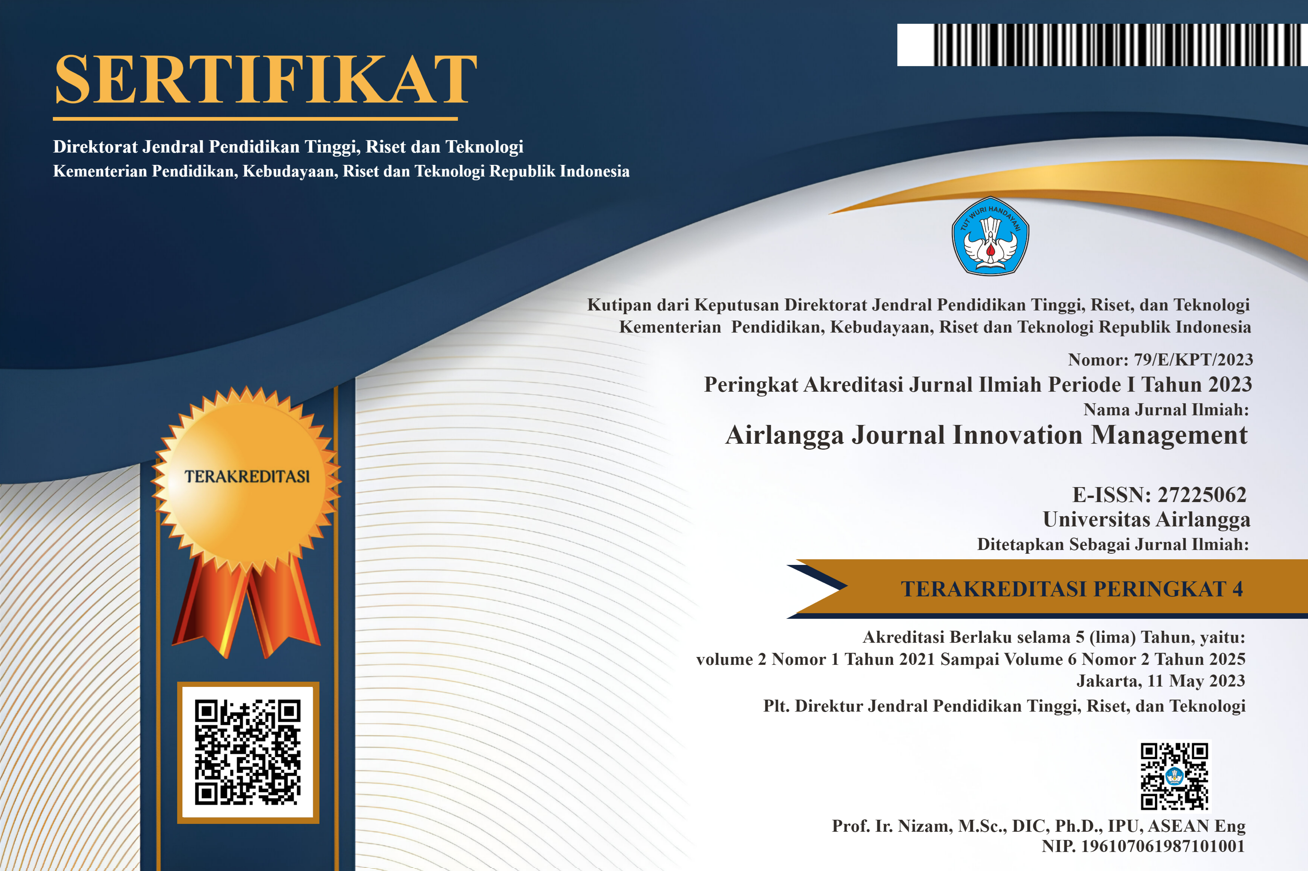A Systems Approach to Understanding the Carbon Emission Pathways and Economic Benefits of Tempeh SMEs Supply Chain in West Java
This study aims to identify and map the tempeh industry's supply chain to understand the economic pathway and carbon emissions. The research method uses a system-based approach with the output of a causal loop diagram that explores the dynamic relationship between variables in the small and medium scale tempeh industry supply chain. The results showed that the potential of the small and medium-scale tempeh industry in West Java is very high, especially in contributing to the economic value of the surrounding community. However, this potential has challenges regarding raw material procurement, where dependence on imported soybean raw material supplies makes the economic value for MSEs or the surrounding community not too large. This is due to the efficiency in the procurement of local soybeans and the inadequate stock of local soybean resilience to meet the needs of tempeh production in West Java’s supply chain. The findings also show that the longer the supply chain, the smaller the profitability and create more environmental impacts related to the carbon emissions generated. This study recommends a policy meeting to cut and streamline, and prioritize local soybeans and increase local soybean resilience stocks to better benefit tempeh SMEs in gaining profitability and minimizing the impact of carbon footprint risks, so that business and industrial activities are more sustainable.
Adirestuty, F., Ratnasart, R. T., Wardhana, A. K., Miraj, D. A., & Battour, M. (2025). Gastronomy of religious tourism: Overview and future research agenda. Geo Journal of Tourism and Geosites, 58(1), 188–199.
Al-Amin, A. Q., Alam, G. M., Fei, Y. S., Azam, M. N., & Karim, Y. O. (2015). Price and Trade Mechanism for Palm and Soybean Oils: A Comparative Analysis of Economic Development between Asia and Contemporary World. Asian Journal of Agricultural Research, 9, 1–11.
Arifin, S., Zaki, I., Ryandono, M. N. H., Zulaikha, S., Hendratmi, A., Rani, L. N., Bayuny, A. F. R., & Wijayanti, I. (2024). Penguatan Kesejahteraan Masyarakat melalui Pelatihan Ternak, Manajemen Keuangan, dan Koperasi Syariah. Jurnal Ilmiah Pengabdian Dan Inovasi, 3(2), 103–124.
Barkah, T., Rusgianto, S., & Wardhana, A. (2022). Impact of Agricultural Land and the Output of Agricultural Products Moderated with Internet Users toward the Total export of Agricultural Product in Three Islamic South East Asian Countries. Media Agribisnis, 6(1 SE-Articles). https://doi.org/10.35326/agribisnis.v6i1.2261
Cho, S., & Yoon, H. (2025). Evaluating the economic and environmental benefits of rice-soybean diversification in South Korea. Agricultural Systems, 224, 104258.
Fauzi, Q., Ulfah, U., & Wijayanti, I. (2024). Ethical challenges in transportation: A study on the implementation of Islamic business values. Al-Uqud: Journal of Islamic Economics, 8(2).
Febriyanti, A. R., Ratnasari, R. T., & Wardhana, A. K. (2022). The Effect of Economic Growth, Agricultural Land, and Trade Openness Moderated By Population Density on Deforestation in OIC Countries. Quantitative Economics and Management Studies, 3(2).
Ghifara, A. S., Iman, A. N., Wardhana, A. K., Rusgianto, S., & Ratnasari, R. T. (2022). The Effect of Economic Growth, Government Spending, and Human Development Index toward Inequality of Income Distribution in the Metropolitan Cities in Indonesia. Daengku: Journal of Humanities and Social Sciences Innovation, 2(4), 529–536.
Harahap, I. A., Kuligowski, M., Cieslak, A., Kołodziejski, P. A., & Suliburska, J. (2024). Effect of tempeh and daidzein on calcium status, calcium transporters, and bone metabolism biomarkers in ovariectomized rats. Nutrients, 16(5), 651.
Harisudin, M., Adi, R. K., & Qonita, R. R. A. (2022). Synergy Grand Strategy Matrix, Swot and Qspm as determinants of Tempeh product development strategy. Journal of Sustainability Science and Management, 17(8), 62–80.
Iman, A. N., Wardhana, A. K., Rusgianto, S., & Ratnasari, R. T. (2022). Venture vs Investment, Which Type of Financing was more Demanded by Agriculture, Forestry, and Aquaculture Sector? Daengku: Journal of Humanities and Social Sciences Innovation, 2(5), 587–595.
Juliansyah, A. F., Putri, A. E., Suryadana, M. L., Endyana, C., & Wardhana, A. K. (2021). Global Muslim Response to Bandung Halal Tourism Branding. International Journal of Applied Sciences in Tourism and Events, 5(2), 197–206. https://doi.org/https://doi.org/https://doi.org/10.31940/ijaste.v5i2.197-206
Kuligowski, M., Radziejewska-Kubzdela, E., Górna, O., Jasińska-Kuligowska, I., & Kidoń, M. (2024). Sustainable Use of By-Products (Okara and Linseed Cake) in Tempeh Fermentation: Effects on Isoflavones and Lignans. Sustainability, 16(22), 9936.
Kuźniacka, J., Biesek, J., Banaszak, M., Rutkowski, A., Kaczmarek, S., Adamski, M., & Hejdysz, M. (2020). Effect of Dietary Protein Sources Substituting Soybean Meal on Growth Performance and Meat Quality in Ducks. Animals, 10(1), 133.
Lo, D., Romulo, A., Lin, J.-Y., Wang, Y.-T., Wijaya, C. H., & Wu, M.-C. (2022). Effect of different fermentation conditions on antioxidant capacity and isoflavones content of soy tempeh. AIMS Agriculture & Food, 7(3).
Loestefani, V., Poan, R., Suwitorahardjo, B., & Wardhana, A. K. (2022). Service Quality and Product Quality as An Influence on Customer Loyalty at Naturalis Koffie. FIRM Journal of Management Studies, 7(2), 211–236.
Mafruchati, M., Othman, N. H., & Wardhana, A. K. (2023). Analysis of the Impact of Heat Stress on Embryo Development of Broiler: A Literature Review. Pharmacognosy Journal, 15(5).
Mafruchati, M., Wardhana, A. K., & Ismail, W. I. W. (2022). Disease and viruses as negative factor prohibiting the growth of broiler chicken embryo as research topic trend: a bibliometric review. F1000Research, 11(1124), 1124.
Mendo, A. Y., Singh, S. K., Yantu, I., Hinelo, R., Bokingo, A. H., Dungga, E. F., Juanna, A., Wardhana, A. K., Niroula, B., & Win, T. (2023). Entrepreneurial leadership and global management of COVID-19: A bibliometric study. F1000Research, 12(31), 31.
Opazo-Basáez, M., Bustinza, O. F., & Molina, L. M. (2024). The effect of industrial solution services (ISS) on innovation performance: The moderating role of sustainable development goals (SDGs). Journal of Cleaner Production, 455(November 2023). https://doi.org/10.1016/j.jclepro.2024.142265
Pramudito, T. E., Desai, K., Voigt, C., Smid, E. J., & Schols, H. A. (2024). Dextran and levan exopolysaccharides from tempeh-associated lactic acid bacteria with bioactivity against enterotoxigenic Escherichia coli (ETEC). Carbohydrate Polymers, 328, 121700.
Prasetyaningsih, E., Renosori, P., & Satori, M. (2020). Conceptual model of start-up business for strengthening Madrasah funding using Dynamic System approaches. In W. I. A. A. I. H. U. D. N. N. R. P. T. D. W. F. F. B. N. C. A. S. A. C. U. M. S. A. N. Abdullah A.G. Suhartanto D. (Ed.), IOP Conference Series: Materials Science and Engineering (Vol. 830, Issue 4). Institute of Physics Publishing. https://www.scopus.com/inward/record.uri?eid=2-s2.0-85086272877&doi=10.1088%2F1757-899X%2F830%2F4%2F042011&partnerID=40&md5=c4ad5294f595cc13cf42cc3447d29e60
Pratiwi, A. C., Wardhana, A. K., & Rusgianto, S. (2022). Application of Vector Error Correction Model on Macroeconomic Variables toward Changes in the Composite Stock Price Index. Daengku: Journal of Humanities and Social Sciences Innovation, 2(2), 219–229.
Qosim, N., Ratnasari, R. T., Wardhana, A. K., Fauziana, H., & Barkah, T. T. (2023). Eight Years of Research Related to the Green Sukuk in the Global Stock Exchange Market to Support the Implementation of SDG: A Bibliometric Review. Journal of Islamic Economic and Business Research, 3(2), 161–180.
Rahman, I., Ratnasari, R. T., & Wardhana, A. K. (2022). Effect of Certificate of Bank Indonesia Sharia and Indonesian Bank Seven Days Repository Rate to Inflation Ratio in Indonesia During Covid-19 Pandemic. Economic Education and Entrepreneurship Journal, 5(1), 157–174.
Ramasu, T., & Kanakana-Katumba, G. (2025). Evaluating the dynamics of fee-free higher education in South Africa: a causal loop diagram approach. F1000Research, 13, 780.
Riduwan, R., & Wardhana, A. K. (2022). Effect of industrial digitalization on total halal meat production in Java. Journal of Halal Product and Research, 5(1), 24–31.
Rozhkov, A., Zellner, M., Murphy, J. T., & Massey, D. (2025). Identifying leverage points for sustainable transitions in urban–rural systems: Application of graph theory to participatory causal loop diagramming. Environmental Science & Policy, 164, 103996.
Rozi, F., Subagio, H., Elisabeth, D. A. A., Mufidah, L., Saeri, M., Burhansyah, R., Kilmanun, J. C., Krisdiana, R., Hanif, Z., & Astuty, E. D. (2025). Indonesian foodstuffs in facing global food crisis: Economic aspects of soybean farming. Journal of Agriculture and Food Research, 101669.
Ryandono, M. N. H., Mawardi, I., Rani, L. N., Widiastuti, T., Ratnasari, R. T., & Wardhana, A. K. (2022). Trends of research topics related to Halal meat as a commodity between Scopus and Web of Science: A systematic review. F1000Research, 11(1562), 1562.
Ryandono, M. N. H., Permatasari, S. A., & Wijayanti, I. (2019). Business behavior in an islamic perspective: Case study of muslim woman entrepreneurs in Ikatan Wanita Pengusaha Indonesia (IWAPI). 12th International Conference on Business and Management Research (ICBMR 2018), 154–159.
Ryandono, M. N. H., Widiastuti, T., Filianti, D., Robani, A., Al Mustofa, M. U., Susilowati, F. D., Wijayanti, I., Dewi, E. P., & Atiya, N. (2025). Overcoming barriers to optimizing cash waqf linked sukuk: A DEMATEL-ANP approach. Social Sciences & Humanities Open, 11, 101588.
Ryandono, M. N. H., Wijayanti, I., Wardhana, A. K., Imron, M. A., & Miraj, D. A. (2025). Stock Market Valuation in Sharia Compliance Lens: An Evaluation of the Intrinsic Value of Sharia-Compliant Stocks. Journal of Posthumanism, 5(2), 1248–1265.
Santoso, T. B., & Kusuma, A. (2023). The Development of the Usage of Blockchain for Waqf and Zakat Globally: A Bibliometric Study. International Journal of Mechanical Computational and Manufacturing Research, 13(3), 83–91.
Setiawan, B., Aulia, S. S., Sinaga, T., & Sulaeman, A. (2021). Nutritional content and characteristics of pumpkin cream soup with tempeh addition as supplementary food for elderly. International Journal of Food Science, 2021(1), 6976357.
Sjamsuridzal, W., Khasanah, M., Febriani, R., Vebliza, Y., Oetari, A., Santoso, I., & Gandjar, I. (2021). The effect of the use of commercial tempeh starter on the diversity of Rhizopus tempeh in Indonesia. Scientific Reports, 11(1), 23932.
Suprayogi, N., Fianto, B. A., Febriyanti, A. R., Sukmaningrum, P. S., Filianti, D., & Wijayanti, I. (2025). PEMBERDAYAAN MASYARAKAT PESISIR DI DESA KWANYAR BARAT, BANGKALAN, MADURA: PERSPEKTIF KEBERLANJUTAN LINGKUNGAN, KESEHATAN, DAN EKONOMI DIGITAL. Jurnal Terapan Abdimas, 10(1), 1–10.
Susanto, A. A., Suprayitno, A., Zulaikha, S., & Wardhana, A. K. (2025). How Islamic Leadership and Islamic Worldview Play a Role in Restoring a Country’s Economic Glory: Blibliometrical Analysis. Jurnal Transformatif (Islamic Studies), 9(1), 40–56.
Tan, Z. J., Bakar, A., Lim, M. F., & Sutimin, H. (2024). Nutritional composition and sensory evaluation of tempeh from different combinations of beans. Food Research, 8(2), 138–146.
Unicef. (2024). The State of Food Security and Nutrition in the World 2024.
Wardhana, A. K. (2023). Applying Islamic Leadership In Working Environment: A Bibliometric Study. Journal Human Resources 24/7: Business Management, 1(1), 25–32.
Wardhana, A. K., & Ratnasari, R. T. (2022). Impact of Agricultural Land and the Output of Agricultural Products Moderated with Internet Users toward the Total export of Agricultural Product in Three Islamic South East Asian Countries. Iqtishodia: Jurnal Ekonomi Syariah, 7(2), 11–20.
Wardhana, A. K., Rusgianto, S., & Fauziana, H. (n.d.). Effect of Timber, Palm Oil, and Gold Output on GNI in Indonesia in the Maqashid Framework.
Wicaksono, W. A., Akinyemi, O. E., Wassermann, B., Bickel, S., Suwanto, A., & Berg, G. (2024). Traditionally produced tempeh harbors more diverse bacteria with more putative health-promoting properties than industrially produced tempeh. Food Research International, 196, 115030.
Wijayanti, I., Herianingrum, S., & Ryandono, M. N. H. (2020). Islamic Crowdfunding Mechanism to Answer Renewable Energy Investment Challenge in Indonesia. Test Engineering and Management, 83, 3596–3605.
Wijayanti, I., & Ryandono, M. N. H. (2020). Zakat institutions’ mustahiq transformation in developing countries: Comparison study. Opcion, 36(S26), 350–366.
Wijayanti, I., Ryandono, M. N. H., & Petra, D. H. S. P. H. (2021). Financial Inclusion through Zakat Institution: Case Study in Indonesia and Brunei Darussalam. International Journal of Islamic Business and Economics (IJIBEC), 5(2), 128–140.
Wikandari, R., Tanugraha, D. R., Yastanto, A. J., Gmoser, R., & Teixeira, J. A. (2023). Development of meat substitutes from filamentous fungi cultivated on residual water of tempeh factories. Molecules, 28(3), 997.
Yarlina, V. P., Djali, M., Andoyo, R., Lani, M. N., & Rifqi, M. (2023). Effect of soaking and proteolytic microorganisms growth on the protein and amino acid content of Jack bean tempeh (Canavalia ensiformis). Processes, 11(4), 1161.
Yudha, A. T. R. C., Huda, N., Maksum, M., Sherawali, S., & Wijayanti, I. (2024). The Moderating Effect of Religiosity on Fashion Uniqueness and Consciousness in Halal Fashion Purchase. Indonesian Journal of Halal Research, 6(2), 71–84.
Zaki, I., Herianingrum, S., Hapsari, M. I., Bayuny, A. F. R., & Wijayanti, I. (2024a). Diversifikasi Pengolahan Frozen Nugget, Pengemasan dan Pemasaran Google Bisnis. JILPI: Jurnal Ilmiah Pengabdian Dan Inovasi, 2(3), 1–10.
Zaki, I., Herianingrum, S., Hapsari, M. I., Bayuny, A. F. R., & Wijayanti, I. (2024b). Diversifikasi Pengolahan Tanaman Obat Tradisional, Pengemasan dan pemasaran Online Di Desa Sugihwaras Kecamatan Prambon Kabupaten Nganjuk. Janaloka, 3(1), 1–8.
Zaki, I., Widiastuti, T., Yudha, A. T. R. C., Wijayanti, I., & Mi’raj, D. A. (2020). Implementation of Islamic entrepreneurial culture in Islamic boarding schools. International Journal of Innovation, Creativity and Change, 11(11), 452–469. https://www.scopus.com/inward/record.uri?eid=2-s2.0-85083043515&partnerID=40&md5=9a6a13d9ca867c26594c27b9a7e69a14
Zakik, Z., Kamil, A., Prasetyo, A. S., Ryandono, M. N. H., & Wijayanti, I. (2022). Economic development on Madura Island through halal tourism: A business feasibility study. Al-Uqud: Journal of Islamic Economics, 6(2), 289–303.
Copyright (c) 2025 Airlangga Journal of Innovation Management

This work is licensed under a Creative Commons Attribution-NonCommercial-ShareAlike 4.0 International License.
- The journal allows authors to hold copyright without restrictions and retain publication rights without restrictions. The author retains the copyright and grants the first publication rights to the journal, with his work simultaneously licensed under the Creative Commons Attribution-NonCommercial-ShareAlike 4.0 International License (CC BY-NC-SA). This license allows others to share the work with acknowledgment of authorship and initial publication in this journal, provided that the work is not used for commercial purposes and that any derivative works must use the same license.
- Authors may enter into additional contractual agreements for non-exclusive distribution of the journal publication version (e.g., uploading it to an institutional repository or publishing it in book form), while still including acknowledgment of the initial publication in this journal.
- Authors are allowed and encouraged to upload their work online (e.g., in an institutional repository or personal website) before and during the submission process. This can support productive scientific exchanges as well as increase citations to published works.

AJIM by UNAIR is licensed under a Creative Commons Attribution-NonCommercial-ShareAlike 4.0 International License.





















